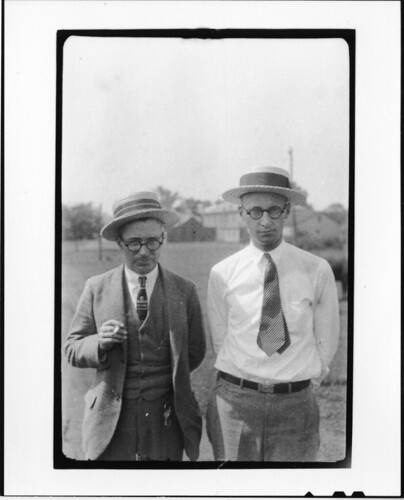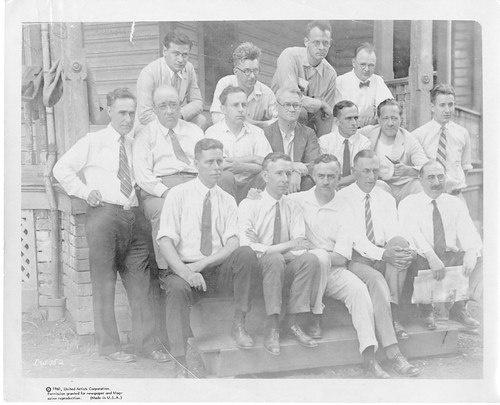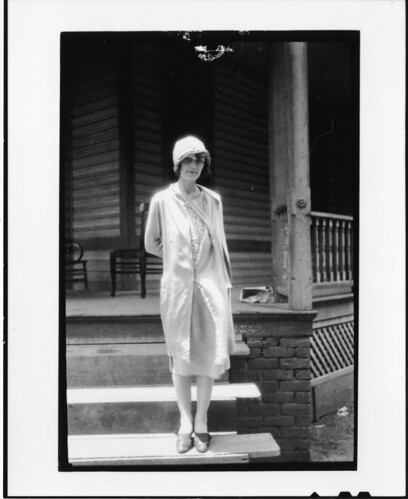This post is the first of three this month that honors the anniversary of the famous Scopes Trial, held in Tennessee from July 10-21, 1925. Written by Marcel Chotkowski LaFollette, Smithsonian Archives Research Associate and author of “Reframing Scopes: Journalists, Scientists, and Lost Photographs from the Trial of the Century" (2008), these posts highlight a set of rare and newly digitized photographs from the Smithsonian Institution Archives collections of witnesses at the trial , which have been added to the Smithsonian Flickr Commons.
"DISTINGUISHED COLLEAGUES OF YOURS HAVE SUGGESTED THAT YOU BE ASKED TO TESTIFY FOR DEFENSE AT ANTIEVOLUTION TRIAL HERE." Thus began dozens of telegrams sent from Dayton, Tennessee, on July 7, 1925, and signed "Clarence Darrow" and "Dudley Field Malone." "WE OF DEFENSE WOULD BE DELIGHTED TO ADD YOUR AUTHORITY TO OUR POSITION...CAN YOU COME AT ONCE WIRE ANSWER STATING TRAIN AND TIME OF ARRIVAL."
High school teacher John Thomas Scopes was about to be tried for teaching evolution, in violation of a new Tennessee state law. Because the controversial case had already attracted national attention and involved celebrated attorneys like Darrow and Malone, the defendent's supporters knew that having scientific experts on hand would be crucial to making as strong a case as possible for the right to teach evolution.
Among the many historical delights at the Smithsonian Institution Archives are numerous behind-the-scenes documents, notes, and photographs related to the Scopes trial. In June 1925, Watson Davis, a journalist for the syndicated news organization Science Service, well aware of the sensational trial’s news-worthiness and importance, interrupted a cross-country train trip to meet with Scopes and George Washington Rappleyea, manager of Dayton's Cumberland Coal & Iron Company and one of the local instigators of the upcoming trial. Upon his return to Washington, DC on July 6, and with the trial scheduled to begin in four days, Davis wired Rappleyea asking for a list of the defense experts. Rappleyea responded with the names of people, including some who, it turned out, had not agreed to appear (and were probably never asked). At that point, Davis and the Science Service staff scrambled to locate experts willing to appear as witnesses, adding or deleting names, and wiring suggestions to Rappleyea, who then telegraphed invitations to them from Dayton. Was this a breach of journalistic neutrality? Yes, but the codes of ethics that exist today were less formal back then. Science Service employees were both protective of science and scientists, and pulled by the newspaper publishers among their trustees to adhere to journalism standards.
Some invitees were out of the country or vacationing in remote places. Some were reluctant to interrupt research projects or summer classes or to be associated with a sensational trial. University of Chicago geologist Rollin T. Chamberlin had an excellent excuse. "CONDITIONALLY WOULD BE GLAD TO TESTIFY," Chamberlin replied on July 8; "HAVE JUST RETURNED FROM HOSPITAL AFTER OPERATION FOR APPENDICITIS COULD NOT COME JUST NOW BUT EXPECT TO BE READY IN A FEW DAYS." Even then, he felt so strongly about the Scopes case that he wired the next day: "WILL COME IF YOU THINK IT NECESSARY."
During the week of July 13, an impressive group of experts made their way to Dayton: Anthropologist Fay-Cooper Cole (1881-1961); zoologist Winterton Conway Curtis (1875-1969); biologist William Marion Goldsmith (1888-1955); psychologist Charles Hubbard Judd (1873-1946); biologist William Allison Kepner (1875-1971); agronomist Jacob Goodale Lipman (1874-1939); geologist Kirtley Mather (1888-1978); zoologist Maynard Mayo Metcalf (1868-1940); geologist Wilbur Armistead Nelson (1889-1969); and zoologist Horatio Hackett Newman (1875-1957). Remarkably, the Archives’ Science Service collections contain photographs of them all, many taken by Davis or his Science Service colleague, Frank Thone, when they boarded, from July 10 to 22, in a mansion that had been set up to serve as the defense team's temporary quarters.
Originally built in 1884 as a residence for the coal and iron company's British owners and managers, the eighteen-room Victorian house was situated on a wooded estate on the outskirts of town. After company bankruptcies and failed reorganizations, the building had fallen into disrepair. (Local teenagers held Halloween parties there, setting candles on the marble mantelpieces and dancing to music from portable phonographs.) During the trial, the decaying, but still-imposing place was quickly dubbed "Defense Mansion," and its wide porches and fading elegance can be glimpsed in many of Davis’ photographs.
Rappleyea and his wife "Precious" had assembled rude accommodations, bringing in mattresses, camp beds, linens, and minimal furniture. Rappleyea, a civil engineer by training, also set up a temporary, erratic water supply, although on the night before the trial opened, there was still no electricity.
Despite such inconveniences, Defense Mansion proved to be a rollicking place. One visitor, minister Charles Francis Potter, described his stay as an adventure dominated by burst pipes and boiled water, interspersed with good conversation and practical jokes. As Frank Thone wrote from Dayton:
“All day long and far into the night the rumble of scientific discussion and laughter issues forth from Defense Mansion, that pleasant old house on the outskirts of Dayton that has become the headquarters for the defenders of science, religion, and freedom.” [Typescript written on or about July 15, 1925, RU7091, Box 365, Folder 3]
Check out the Archives Resources Mentioned Above:
- Tennessee v. John Thomas Scopes Trial Photographs, Smithsonian Flickr Commons Set
- Finding Aid: Record Unit 7091 Science Service, Records, 1902-1965
- Blog Posts about the Tennessee v. John Thomas Scopes Trial and Photos
Produced by the Smithsonian Institution Archives. For copyright questions, please see the Terms of Use.






Leave a Comment